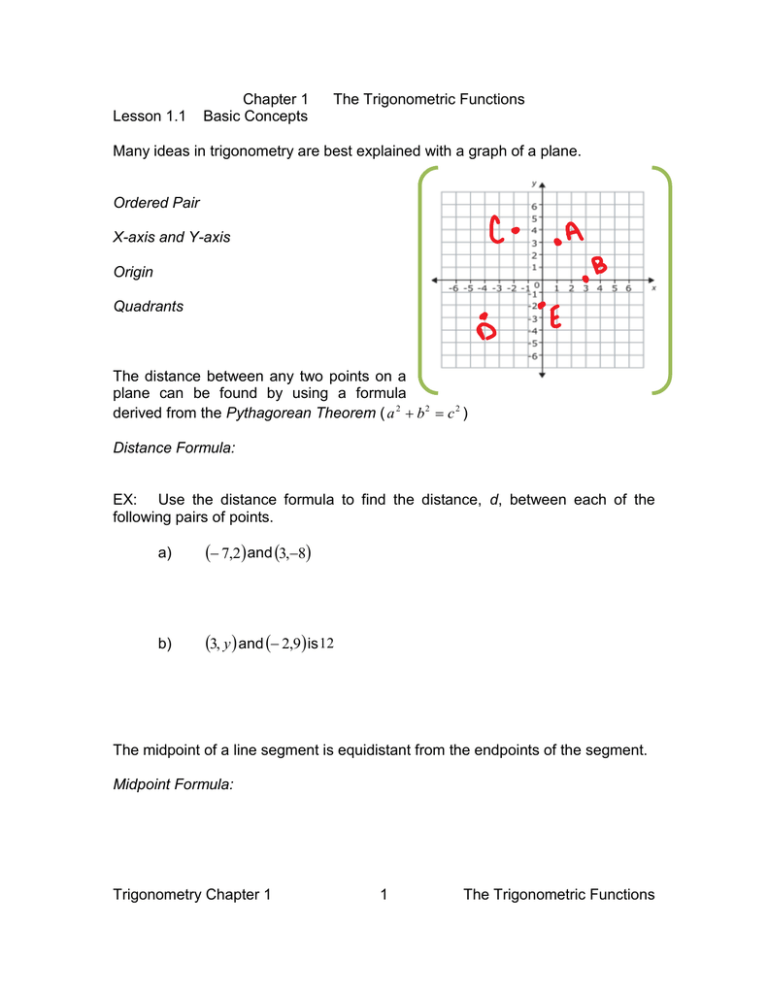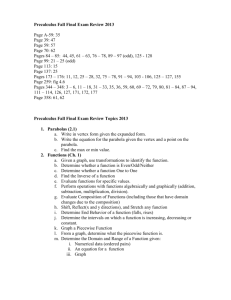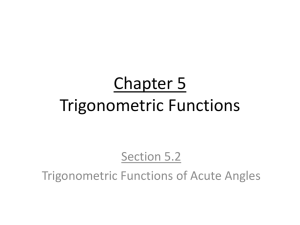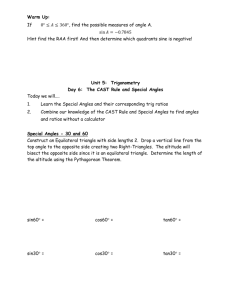Chapter 1 - Cloudfront.net
advertisement

Lesson 1.1
Chapter 1
Basic Concepts
The Trigonometric Functions
Many ideas in trigonometry are best explained with a graph of a plane.
Ordered Pair
X-axis and Y-axis
Origin
Quadrants
The distance between any two points on a
plane can be found by using a formula
derived from the Pythagorean Theorem ( a 2 b 2 c 2 )
Distance Formula:
EX: Use the distance formula to find the distance, d, between each of the
following pairs of points.
a)
7,2 and 3,8
b)
3, y and 2,9 is 12
The midpoint of a line segment is equidistant from the endpoints of the segment.
Midpoint Formula:
Trigonometry Chapter 1
1
The Trigonometric Functions
EX: Use the midpoint formula to find the midpoint of the line segment joining
the two points.
a)
8,4 and 9,6
b)
Endpoint 2,8 and midpoint 1,3 , find the other endpoint.
It is often necessary to specify sets of numbers defined by inequalities. Interval
Notation will be used to indicate the sets of numbers.
{𝑥|𝑥 > 𝑎} {𝑥|𝑎 < 𝑥 < 𝑏} {𝑥|𝑥 < 𝑏}
Open Interval
{𝑥|𝑎 ≤ 𝑥 ≤ 𝑏}
Closed Interval
{𝑥|𝑥 ≥ 𝑎} {𝑥|𝑎 < 𝑥 ≤ 𝑏} {𝑥|𝑥 ≤ 𝑏}
Half-open Interval
𝑅
Real Numbers
A relation is defined as a set of ordered pairs. Many relations have a rule or
formula showing the connection between the two components of the ordered
pairs.
For example, the formula y 5 x 6
shows that a value of y can be found
from a given value x by multiplying the value of x by 5 and then adding 6 . In the
relation, the value of y depends on the value of x , so that y is the dependent
variable and x is the independent variable.
Most of the relations in trigonometry are functions.
Function:
EX:
Using function notation, find the following.
a)
f x x 2 x 5
Trigonometry Chapter 1
f 0
f 4
f a
2
The Trigonometric Functions
For a relation to be a function, each value of x in the domain of the function must
lead to exactly one value of y .
Domain:
Range:
By observing the graph of a relation, it is often easy to determine the domain and
the range. It is also easy to determine if the relation is a function, by using the
Vertical Line Test:
EX: Find the domain and range for the following relations.
functions.
EX:
a)
y x2
b)
3x 2 y 6
c)
x y2 2
d)
y 1 x
Identify any
Find the domain for the following functions.
a)
y
8 x
2 x 34 x 1
Trigonometry Chapter 1
b)
3
y
1
x 2 16
The Trigonometric Functions
Lesson 1.2
Angles
An Angle is two rays connected by an endpoint formed by rotating a ray around
its endpoint.
Parts of Angle
Initial Side:
Vertex:
Terminal Side:
If the rotation of the terminal side is counterclockwise, the angle is positive. If
the rotation is clockwise, the angle is negative.
An angle can be named by using the name of its vertex or by using the three
letters, with the vertex in the middle. There are two systems in common use for
measuring the size of angles. The most common unit of measure is the degree
and the other unit of measure is the radian, which is discussed in Chapter 3.
Types of Angles
Acute angle:
Right angle:
Obtuse angle:
Straight angle:
If the sum of the measures of two angles is 90 , the angles are called
complementary.
Two angles with measures whose sum is 180 are
supplementary.
Much of the study of trigonometry involves finding angle measures. Angles are
measured with an instrument called a protractor. But what happens if it is not a
whole degree? We then find the portion of the degree in minutes and seconds.
One minute, written 1 , is
1
of a degree.
60
One second, written 1 , is
1
of a minute.
60
Trigonometry Chapter 1
4
60 1
1
1
1
or 60 1
60
3600
The Trigonometric Functions
For example, 124238 represents 12 degrees, 42 minutes, and 38 seconds.
Ex:
Perform each calculation.
a)
5129 3246
b)
90 7312
But since most calculators don’t have minutes or seconds, we convert to decimal
degrees. We will also convert decimal degrees to minutes and seconds.
EX:
Convert as indicated. Round to the nearest thousandth of a degree.
a)
742815
b)
34.817
An angle is in standard position if its vertex is at the origin and its initial side is
along the positive x-axis. An angle in standard position is said to lie in the
quadrant in which its terminal side lies. Angles in standard position having their
terminal sides along the x-axis or y-axis, such as angles with measures
90,180,270, and so on, are called quadrantal angles.
A complete rotation of a ray results in an angle of measure 360 . But there is no
reason why the rotation needs stop at 360 . By continuing the rotation, angles of
measure larger than 360 can be produced.
The angles in the figure have measures
of 60 and 420 . These two angles have
the same initial side and the same
terminal side, but different amounts of
rotation. Angles that have the same
initial side and the same terminal side
are called coterminal angles.
Trigonometry Chapter 1
5
The Trigonometric Functions
EX: Sketch the angle in standard position. Draw an arrow representing the
correct amount of rotation. Find the measure of two other angles, one positive
and one negative, which is coterminal with the given angle. Give the quadrant of
each angle.
a)
225
b)
290
c)
908
d)
539
EX: A phonograph record revolves 45 times per minute. Through how many
degrees will a point on the edge of the record move in 2 seconds?
Trigonometry Chapter 1
6
The Trigonometric Functions
Lesson 1.3
Angle Relationships and Similar Triangles
In this section we look at some geometric properties that will be used in the study
of trigonometry.
Vertical angles: two angles are called
vertical angles if and only if they are two
nonadjacent angles formed by two
interesting lines.
They have equal
measures.
When a line q intersects two parallel lines, m and n , is called a transversal. The
transversal intersecting the parallel lines forms eight angles indicated by
numbers. It is shown in geometry that angles 1 through 8 in the figure possess
some special properties regarding their degree measures.
Alternate Interior angles
𝑎
Alternate Exterior angles
𝑏
Interior angles on the Same side of
Transversal
𝑎‖𝑏
Corresponding angles
Angle Sum of a Triangle:
EX:
Find the measure of each marked angle.
a)
b)
(6𝑥 − 70)°
𝑎‖𝑏
(3𝑥 + 2)°
(3𝑥 + 20)°
𝑎
𝑏
(5𝑥 − 40)°
c)
(𝑥 + 15)°
(𝑥 + 5)°
(10𝑥 − 20)°
Trigonometry Chapter 1
7
The Trigonometric Functions
d)
The measures of two angles of a triangle are given. Find the measure of
the third angle.
14712,3019
Triangles are classified according to angles and sides as shown in the chart.
Types of Triangles
Angles
Acute Triangle
Right Triangle
Obtuse Triangle
Sides
All acute angles
Equilateral Triangle
One right angle
Isosceles Triangle
One obtuse angle
Scalene Triangle
All sides equal
Two sides equal
No sides equal
Many key ideas of trigonometry depend on similar triangles, which are triangles
of exactly the same shape but not necessarily the same size.
𝐵
Conditions for Similar Triangles
𝐷
𝐴
𝐶
𝐹
1.
Corresponding angles must have
the same measure.
2.
Corresponding sides must be
proportional. (Ratios must be equal)
𝐺
Congruent triangles are triangles that are both the same size and the same
shape. If two triangles are congruent, then it is possible to pick one of them up
and place it on top of the other so that they coincide. If two triangles are
congruent, then they must be similar. However, two similar triangles need not be
congruent.
Trigonometry Chapter 1
8
The Trigonometric Functions
EX: Triangles ACB and NPM are similar. Find the measures of the missing
angles and the missing sides.
N
8
A
P
45°
M
104°
32
16
C
24
B
∆𝐴𝐶𝐵~∆𝑁𝑃𝑀
EX: The people at the Arcade Fire Station need to measure the height of the
station flagpole. They notice that at the instant when the shadow of the station is
18 feet long, the shadow of the flagpole is 99 feet long. The station is 10 feet
high. Find the height of the flagpole.
Trigonometry Chapter 1
9
The Trigonometric Functions
Lesson 1.4
Definitions of the Trigonometric Functions
The study of trigonometry covers the six trigonometric functions defined in this
section. Most sections in the remainder of this book involve at least one of these
functions.
To define these six basic functions, start
with an angle (the Greek letter theta)
in standard position. Choose any point
P having coordinates x, y on the
terminal side of angle . (The point P
must not be the vertex of the angle.) A
perpendicular from P to the x-axis at
point Q determines a triangle having
vertices at O, P, and Q . The distance r
( r 0 , since distance is never negative)
from Px, y to the origin, 0,0 can be
found from the distance formula.
r
x 02 y 02
r
x2 y2
The six trigonometric functions of angle are defined as followed:
Sine
sin
Cotangent
y
r
cot
x
y
Cosine
cos
x
r
Tangent
tan
y
x
Secant
sec
r
x
Cosecant
csc
r
y
NOTE:
Although the figure shows a first quadrant angle, these definitions
apply to any angle . Because of the restrictions on the denominators in the
definitions of tangent and secant x 0 , and cotangent and cosecant y 0
some angles will have undefined function values. This will be discussed in more
detail later.
Trigonometry Chapter 1
10
The Trigonometric Functions
EX: The terminal side of an angle (alpha) goes through the point 8,15 . Find
the values of the six trig functions of angle .
OQ 8 x
OP
PQ 15 y
8 02 15 02
OP 82 152 64 225
OP 289
OP 17 r
The values of the six trig functions of angle can be found.
sin
y 15
r 17
cos
x 8
r 17
sec
r 17
x 8
csc
r 17
y 15
tan
y 15
x 8
cot
x 8
y 15
EX: The terminal side of angle (beta) goes through the point 3,4 . Find
the values of the six trig function of angle .
Therefore to find the values of the six trig functions, you must be able to form a
right triangle and use an arbitrary point and the origin for this lesson using the
standard position angles. Then find the values of x and y by counting the units
from the origin and r by using the Pythagorean Theorem and finally plug those
values into the six trig functions.
Trigonometry Chapter 1
11
The Trigonometric Functions
We can also find the trig function values of an angle if we know the equation of
the line coinciding with the terminal ray. Recall from algebra that the graph of the
equation Ax By 0 is a line that passes through the origin. If we restrict x to
have only nonpositive or only nonnegative values, we obtain as the graph a ray
with endpoint at the origin. Such a ray can serve as the terminal side of an angle
in standard position. By finding a point on the ray, the trig function values of the
angle can be found.
EX: Find the six trig function values of the angle in standard position, if the
terminal side of is defined by x 2 y 0, x 0 .
NOTE:
The trigonometric function values we found in the previous
examples are exact. If we were to use a calculator to approximate these values,
the decimal results would not be acceptable if exact values were required.
If the terminal side of an angle in standard position lies along the y-axis, any
point on this terminal side has x-coordinate 0. Similarly, an angle with terminal
side on the x-axis has y-coordinate 0 for any point on the terminal side. Since
the values of x and y appear in the denominators of some of the trig functions,
and since a fraction is undefined if its denominator is 0, some of the trig function
values of quadrantal angles will be undefined.
EX:
Find the values of the six trig functions for an angle of 90 .
Trigonometry Chapter 1
12
The Trigonometric Functions
Since the most commonly used quadrantal angles are 0,90,180,270 and 360 ,
the values of the functions of these angles are summarized in the following table.
This table is for reference only: you should be able to reproduce it quickly.
0
90
180
270
360
EX:
sin
0
1
0
-1
0
cos
1
0
-1
0
1
tan
cot
sec
csc
0
Undefined
1
Undefined
Undefined
0
Undefined
1
0
Undefined
-1
Undefined
Undefined
0
Undefined
-1
0
Undefined
1
Undefined
Evaluate each of the following.
a)
sin 90 4 cos 270
b)
cos 2 90 2 csc 2 90
The values given in the table can also be found with a calculator that has trig
function keys. First, make sure the calculator is set for degree mode. But there
are no calculator keys for finding the function values of cotangent, secant, or
cosecant. The next section shows how to find these function values with a
calculator.
Trigonometry Chapter 1
13
The Trigonometric Functions
Lesson 1.5 Using the Definitions of the Trigonometric Functions
In this section several useful results are derived from the definitions of the
trigonometric functions given in the previous section. First, recall the definition of
1
a reciprocal: the reciprocal of the nonzero number x is . Looking back at the
x
definitions of the trig functions, we see that there are some trig functions that are
just reciprocals of each other.
For example, sin
y
1
1
r
and csc therefore sin
and csc
r
csc
sin
y
We have the reciprocal identities that hold for any angle that does not lead to
a zero denominator.
1
csc
1
cos
sec
1
tan
cot
1
sin
1
sec
cos
1
cot
tan
sin
EX:
csc
Find each function value.
a)
cos if sec
5
3
b)
sin if csc
12
2
In the definition of the trigonometric functions, r is the distance from the origin to
the point x, y . Distance is never negative, so r 0 . The location of the angle
determines the sign of the trig function, since the quadrant will tell us if x and y
are positive or negative.
Quad II
y
r
r
csc
y
sin
Trigonometry Chapter 1
14
x, y
r 0 90 180
x
y
cos
tan
r
x
r
x
sec
cot
x
y
The Trigonometric Functions
Ranges of Trigonometric Functions
With an angle drawn on a coordinate plane, the right triangle formed has
certain distance values. The r will always be the longest side or distance.
Dividing both sides by the positive number r gives
y r and x r
y
x
y
x
1 and 1
Similarly, also 1 and 1
r
r
r
r
and
for
any
angle
1 sin 1
1 cos 1
The functions sec and csc are reciprocals of the functions cos and sin ,
respectively, making sec 1 or sec 1 and csc 1 or csc 1 . Therefore,
sec and csc are never between -1 and 1.
The tangent of an angle is defined as tan
x y , or that x y . For this reason
be any real number, as can cot .
EX:
y
. It is possible that x y , that
x
y
can take on any value at all, so tan can
x
Decide whether the following statements are possible or impossible.
a)
sin 8
b)
tan 110.47
c)
sec 0.6
The six trigonometric functions are defined in terms of x, y , and r , where the
Pythagorean Theorem shows that r 2 x 2 y 2 and r 0 .
With these
relationships, knowing the value of only one function and the quadrant in which
the angle lies makes it possible to find the values of all six of the trigonometric
functions.
Trigonometry Chapter 1
15
The Trigonometric Functions
EX:
Suppose that angle is in quadrant II and sin
2
. Find the values of the
3
other five functions.
y 2
r 3 and y 2 , so we need to find x
r 3
x 2 2 2 32
To find x , use the formula x 2 y 2 r 2
x2 4 9
x2 5
x 5
sin
But since is in Quadrant II, we know that x 5 because x 0
x 5. y 2, r 3 , so we plug in the numbers in the definitions.
sin
y 2
r 3
cos
x 5
r
3
csc
r 3
y 2
sec
r
3
5 3 5
x 5 5
5
EX:
tan
y
2
5 2 5
x 5 5
5
cot
x 5
y
2
Suppose that angle (gamma) is in quadrant III and cot
6
. Find the
8
values of the other five functions.
Trigonometry Chapter 1
16
The Trigonometric Functions
Pythagorean Identities
We can derive three more very useful new identities from the relationship
x2 y2 r2 .
2
Dividing both sides by r gives
x2 y2 r2
r2 r2 r2
2
2
x y
1
r r
cos 2 sin 2 1
2
Dividing both sides by x gives
x2 y2 r2
x2 x2 x2
2
2
x
r
1
y
y
2
y
r
1
x
x
1 tan 2 sec 2
2
Dividing both sides by y gives
x2 y2 r2
y2 y2 y2
2
cot 2 1 csc 2
Quotient Identities
sin
tan
cos
EX:
cos
cot
sin
Find the other five trig functions if cos
Trigonometry Chapter 1
17
3
and is in quadrant II.
4
The Trigonometric Functions






